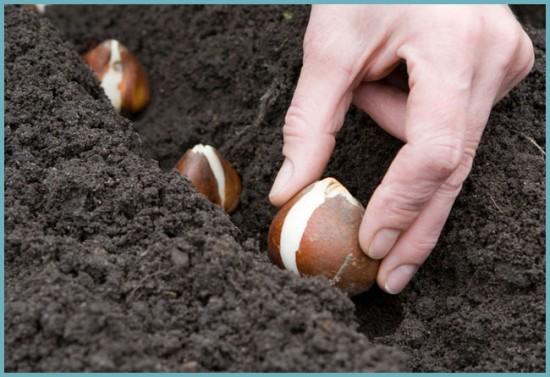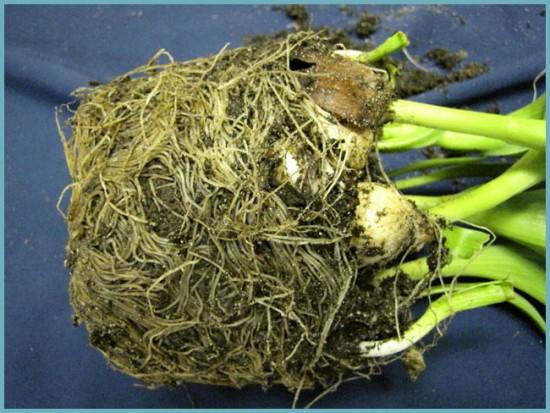Growing tulips outdoors and caring for flowers
Tulips are grown mainly outdoors:
- for cutting;
- to obtain new planting material;
- for decorative purposes.
Many gardeners are interested in the question of when to dig up tulips after flowering and how to store them before planting. Indeed, in summer, tulip bulbs need to be dug out after flowering and drying of the stems, so that the flower is strong and healthy. Drying refers to the yellowing of the stems by about two-thirds. All harvested tulip bulbs are dried in a warm, dry place with good ventilation. Then they are sorted out, removing defective and spoiled bulbs, sorted and treated with fungicide solutions. This will help you prepare your tulip bulbs for planting in advance. Store tulips before planting in dry, ventilated areas. The storage temperature should be 17-20 degrees.

Correct care
After the germination of the bulbs, caring for the planting of tulips begins with a careful examination and rejection of rotten specimens. Then you need to gently loosen the bed, and the culture responds well to loosening. Caring for young plants is reduced to regular watering, but not abundant, but moderate, but the topsoil in a plant bed should never dry out.
 Tulip sprouts
Tulip sprouts
Providing regular and necessary fertilizing to growing tulips, daily careful maintenance, regular watering will help to grow healthy, vibrant flowers. And the most important thing to remember: after 4 years, tulip beds should be broken up in a different place.
Planting a plant
Planting tulips is most favorable when the soil temperature on the site is + 7-10 ° C. The soil cools down to such values in autumn, usually at the beginning of October, but in the southern regions it is possible to plant tulips in late periods - until the end of November.
At high soil temperatures, roots do not form for a long time, creating a high risk of plant disease with Fusarium. Planting bulbs at the first frost also poses certain dangers - the bulbs do not have time to take root before the onset of severe frosts.
 Plant tulips in the fall
Plant tulips in the fall
The beds for planting bulbs are set aside in the brightest, sunniest place. Care should be taken in advance to protect the landings from the wind. The soil for culture requires loose and rich in humus. Heavy clay soils, as well as poor sandy soils, require improvement. There should be no stagnant water in the garden. The high water table in the tulip planting site is detrimental to the bulbs. Good drainage is required.
The site for planting tulip bulbs must be carefully dug up, all weeds must be removed. It is advisable to treat perennial weeds with special preparations for destruction.
Advice: It is strictly forbidden to bring un-rotted manure into the beds set aside for tulips.
It is useful to start planting tulips by examining the bulbs. Rotten or mummified bulbs must be removed. Healthy planting material is soaked in a solution of potassium permanganate (pink) for 30 minutes. Immediately after soaking, the bulbs are planted in prepared furrows. The planting depth of tulip bulbs is determined by their height multiplied by 3. The distance between the bulbs is 10 cm. The planting furrows are laid at a distance of 25-30 cm from each other. The furrows are pre-watered with water, growth stimulants, a layer of dry fertilizer for bulbous flower crops is scattered, and the furrows are sprinkled with a thin layer of sand. Bulbs are laid on top of the sand: you cannot press them into the ground.
 The distance between the bulbs can be small - about 10 cm
The distance between the bulbs can be small - about 10 cm
In November-December, with the onset of frost, it is useful to mulch the top layer of the beds with a layer of peat (3-5 cm). Peat is not harvested in spring.
Tulips after flowering
Caring for tulips after flowering
Feed faded tulips with potassium-phosphorus fertilizer; remove the ovaries so that they do not take food away from the bulbs; if there are stems, do not cut them; Water the plants for another two weeks after the flowers wither, then gradually reduce the watering, and when the leaves turn yellow and wither, dig up the bulbs. As you can see, caring for tulips after flowering is not difficult.
When to dig tulips after flowering
Novice growers sometimes make the mistake of leaving tulip bulbs in the ground all summer. In fact, this can only be done with red varieties, and even then not with all. The fact is that the flowers of tulips left in the ground become smaller, and the stems become thinner and shortened. This happens because the mother's bulb, with the appearance of babies, goes deeper into the ground, pushing the babies closer to the surface, and the next year we get the flowers of the babies, and not a large mother bulb that buried itself in the ground.
Do not repeat other people's mistakes: when the leaves of the tulips begin to dry naturally, and the end of the stem easily wraps around your finger, it's time to dig up the bulbs. It is better to do this with a bayonet shovel, prying the ground deeper than the bulbs sit.
Varieties of tulip varieties
Tulips are conventionally divided into IV groups and 15 classes. But the most common are the first 6 grades.

Class I (early simple tulips) include such varieties as Demeter, Golden Olga. This class is distinguished by short but persistent pedicels (20-40 cm). The shape of the flower is goblet and cupped, the color is yellow and red.

Class II (simple double tulips) - Madame Testu, Shunord. Peduncles 30 cm long, yellow and red double flowers, up to 9 cm in diameter, have a long flowering period.

III class (tulips-triumph) - Snowstar, Crater. The stems are up to 60 cm, the flowers are large, goblet-shaped, the color range is varied: from light to dark tones.

Class IV (Darwin's hybrids) includes Apeldoorn, Vivex. The sprouts reach a height of 80 cm. Flowers up to 12 cm in diameter, have an intense red tint, there are other tones of red, as well as bicolor specimens. They are not afraid of frost.

Class V (Bacchus, Georgette -tulips are simple late) strong and long (80cm) pedicels. Flowers are goblet and large in size. Large variety of colors, there are two-tone types.

VI class - Gisella, Red Shine (lily flowers). A goblet flower with characteristic deflected and pointed petals, multicolored color. Stem up to 50 cm.

Tulip care: watering and feeding flowers
A well-drained neutral or slightly alkaline soil with a high nutrient content is suitable for growing tulip flowers. The plant prefers sunny and sheltered places from the wind. In one place without transplanting it grows well for 3-4 years, but it is recommended to plant it in a new place every year.
Tulip bulbs must be examined before planting and damaged planting material must be discarded. The fact is that the risk of disease in scratched bulbs is too high to be planted next to healthy ones. The planting material remaining after inspection should be soaked in a 0.1% decis solution for about 15-20 minutes.
Watering tulips should be done regularly and abundantly, provided that the weather is warm. Watering is stopped 3 weeks after the end of flowering. The soil between the plants is loosened and weeded.
The first dressing of tulips is carried out after the emergence of shoots (1 tbsp. L. Urea per 1 m2. The second time the soil is fertilized before the appearance of buds. The third dressing of tulips is necessary during the period of active formation of buds. The fourth falls at the beginning of flowering.When caring for tulip flowers from fertilizers, superphosphate, potassium sulfate and special fertilizers for flower plants are used.
Another tip for growing tulips: the plot is mulched for the winter, and the mulch is removed in the spring. The bulbs can also be dug up and stored in a cool, dark place.
Tulips are propagated by bulbs. They are planted in autumn in pits at a depth of 3 times the height of the bulbs. The distance between them is made by 15-20 cm. They are sprinkled with earth on top and slightly trampled. The soil is dug up and leveled 10 days before the work is carried out, and when planting, wood ash, humus, nitrophosphate are introduced into it.
Tulips are affected by penicillosis, fusarium, bulbous and tulip sclerotiniasis, bacterial rot, gray mold, variegation. The most dangerous pest for them is the bulb mite.
Diseases and pests
Tulips are damaged by a huge number of pests and diseases: today there are more than 30 infections affecting tulips.
Growing tulips largely depends on the choice of planting material. Bulbs should be free from mechanical damage, ulceration, black soot spots and dry crusts.
The greatest harm to tulip plantings is caused by gray rot, fusarium, sclerocial rot. The most dangerous viral infection of a culture is variegation.
 Tulip disease - gray rot
Tulip disease - gray rot
Gray rot of tulips (Botrytis tulipae) develops on plants in cold and damp weather, especially when planted in open ground with heavy soil, which has not been loosened. The disease progresses rapidly: fungal spores spread to all parts of the plant. Growth slows down, buds become smaller, stems and leaves bend and soften. The main thing is to notice diseased plants or planting material at the time and isolate from uninfected tulips. In the spring, it is necessary to inspect seedlings to destroy diseased plants.
Preventive measures against gray rot are dusting the bulbs with sulfur, etching the bulbs with a solution of TMTD. The green mass is sprayed with Bordeaux mixture 1% or euporene 0.5-1%.
It is easy to prevent the development of the disease - a sufficient amount of potassium fertilizers should be applied to the soil, and magnesium from microelements.
 Root rot of tulips
Root rot of tulips
Root rot, causative agent - Ruthium fungi. Brown spots appear on the roots of tulips, which gradually spread to the entire root system. Properly prepared soil reduces the risk of plant diseases.
In addition, the following lesions threaten tulips: soft rot (Pythium ultimum), white rot (Scleritiniabulborum, Sclerotium tuliparium), fusarium (Fusarium oxysporum f. Sp. Tulipae), trichoderma (Trichoderma sp).
Viral diseases of tulips are represented by the most common of them - variegation. Throughout the green mass of the flower, including the petals and buds, variegated strokes appear. The virus is carried by pests with the sap of diseased plants. There is no cure. Diseased plants are destroyed.
Lily tulips general description.
Lily-colored tulips are one of the smallest classes in terms of the number of varieties and species. They are very decorative and outwardly different flowers with different colors. The average height of representatives of this class is 50-60 cm. Almost all varieties included in this group are distinguished by single flowering. Stems can be leafless or leafy, and at the base, a basal rosette of 2-4 leaves, elongated, with a peak-like shape, is necessarily formed.
The main feature of the class is the shape of flowers that resemble lilies, for which the section was named so. Tepals, that is, petals, are elongated, with a pointed end, and bend outward during the flowering period. The sizes of flowers are different - there are large varieties, and there are small ones. Small-flowered varieties are natural, and varieties with large flowers were bred by breeders in the 20th century, by hybridization.
Lily-colored tulips are a class that unites such varieties that not every grower can grow. They are extremely demanding, prone to disease, do not have resistance to viral diseases, in particular to variegation. In addition, the growth characteristics and reproduction rate of flowers are relatively low. Against the background of other species, they are distinguished only by their extraordinary decorativeness.
Flowering time
Unlike other late flowering tulips, the sixth class bloom a little later - usually this phase begins in the second half of May. Earlier flowering of lily-colored tulips is possible only in the case of winter forcing. This is a popular type of cultivation, as the varieties are very good for cutting and decorating the first spring bouquets.
Popular varieties
As already mentioned above, the sixth class is one of the fewest in the varieties and hybrids included in it. But, even among them there are those that have spread all over the world, cultivated in different countries, and also gained popularity in gardening. Consider the main varieties of the sixth grade.
Features of plant care
In early spring, when tulip sprouts begin to appear from under the ground, gardeners are faced with the task of proper tulip care.

Firstly, in order to ensure the health of the plants, it is necessary to get rid of the flowers that have not sprouted and become diseased.

Secondly, watering the bulbs frequently is one of the main requirements, but do not overfill them as the bulbs will start to rot. To preserve the moisture of the earth, it must be periodically loosened.

Thirdly, timely “feeding” of tulips is an important condition for active growth. For the first time, it is necessary to revive them in early spring, as soon as young stems begin to be seen, dry phosphorus, nitrogen and potassium (2: 2: 1) are scattered on top of the soil in accordance with 50 g per 1 m².

The second time, tulips are fed when the budding period occurs, only at the moment it is more competent to apply a solution of the above-mentioned dobrev (nitrogen - 1 part, phosphorus and potassium - 2 parts).

And the last - the third feeding, occurs when the tulips have bloomed, only for feeding I use phosphorus and potassium (1: 1), counting up to 35 g per 1 m². For better growth of additional (daughter) bulbs, zinc and boron are mixed into the solution.







Kaufman tulips general description
The Kaufman tulip class is represented by a variety of varieties, in various colors and flower sizes. They are united by their short stature - such varieties grow to a maximum of 25-30 cm, and there are also very small ones, the height of which is no more than 15-20 cm.
The flowers are also relatively small, but this does not make them look less decorative. The small size is entirely compensated by the brightness of the colors - in most varieties, the petals are painted in 2-3 or more shades. An unusual, star-shaped flower with pointed petals makes tulips look more voluminous. A typical feature of the representatives of Kaufman tulips is a double color, because in the inner side of the petal the shade can differ significantly from the color that covers the petal on the outside.
Kaufman tulips reproduce excellently, both vegetatively and by seed. But, even in good conditions, when grown from seed, flowering can begin no earlier than in the fifth year of plant development. For regions with a warm, arid climate, tulips of the twelfth class are ideal - they winter in the open field, do not freeze and give a long, early flowering next year. In northern regions, where winters are characterized by extremely low temperatures and high humidity, it is recommended to dig up the bulbs to avoid their death before the new season.
The main application of representatives of this class is growing for the sake of creating bouquets that are distinguished by incredible beauty and the ability to maintain freshness for a long time.Kaufman tulips are also successfully used for landscaping, because they are one of the first to decorate with bright flowering flower beds, flower beds, alpine slides and park paths that have not yet become accustomed to the winter cold.
Flowering time
The main feature of the varieties collected in this class has already been described above - they all have the ability to bloom very early, 2-3 weeks earlier than other tulips. The varieties included in the twelfth grade begin to open their petals in early April, and sometimes in the second half of March. The earlier spring begins, the farther south tulips grow, the earlier they begin to open their buds. Usually, the flowering of such varieties lasts for 2-3 weeks, but the exact time depends on many factors - from the genetic characteristics of the variety to the age of the plant and growing conditions.
Popular varieties
More than two hundred varieties - this is the number of the Kaufman tulip class. But, almost 70% of them are quite rare varieties, preserved only in separate collections, botanical gardens. Only a few dozen varieties are massively grown, and the following varieties are the most popular.


